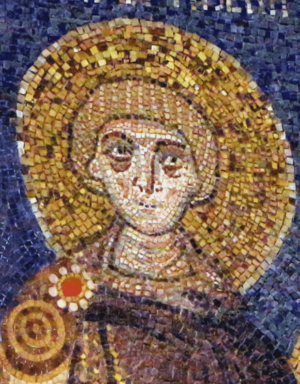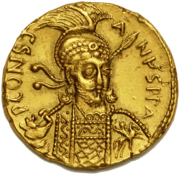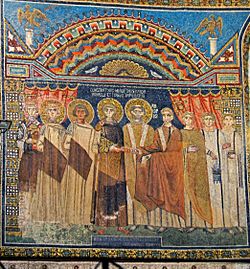Constantine IV facts for kids
Constantine IV (born around 650 – died July 10, 685) was a powerful Byzantine emperor who ruled from 668 to 685. He is sometimes called "the Younger." His time as emperor was very important because he stopped the rapid expansion of the Islamic empire, especially by successfully defending Constantinople from a long siege by the Arabs.
He also called the Sixth Ecumenical Council, a major meeting that helped end a big religious disagreement in the Byzantine Empire about something called monothelitism. Because of his actions, he is honored as a saint in the Eastern Orthodox Church, with his special day on September 3.
Quick facts for kids Constantine IV |
|||||
|---|---|---|---|---|---|
| Emperor of the Romans | |||||

Constantine IV, mosaic in basilica of Sant'Apoll'Apollinare in Classe, Ravenna.
|
|||||
| Byzantine emperor | |||||
| Reign | September 668 – July 685 | ||||
| Coronation | 13 April 654 | ||||
| Predecessor | Constans II | ||||
| Successor | Justinian II | ||||
| Co-emperors |
|
||||
| Born | c. 650 Constantinople (now Istanbul, Turkey) |
||||
| Died | 10 July 685 (aged c. 35) Constantinople |
||||
| Burial | Church of the Holy Apostles, Constantinople | ||||
| Spouse | Anastasia | ||||
| Issue |
|
||||
|
|||||
| Dynasty | Heraclian | ||||
| Father | Constans II | ||||
| Mother | Fausta | ||||
| Religion | Chalcedonian Christianity | ||||
| Saint Constantine the New |
|
|---|---|
| Holy and Right-Believing Emperor of the Romans | |
| Venerated in | Eastern Orthodoxy |
| Major shrine | Church of the Holy Apostles |
| Feast | 3 September |
| Attributes | Imperial attire |
Contents
Becoming Emperor
Constantine IV was the oldest son of Emperor Constans II. He was made a co-emperor with his father in 654. This happened on Easter, April 13. He was likely born around 650.
He became the main emperor in September 668. This was after his father, Constans II, was sadly killed in Sicily.
Dealing with Rebellions and Threats
Constantine's first big challenge was stopping a military rebellion in Sicily. This revolt had led to his father's death. Within seven months, Constantine IV put down the rebellion. He had help from Pope Vitalian.
However, new problems quickly appeared in the East. The Caliph Muawiyah I, a leader of the Arabs, was invited to attack Constantinople. He sent an army led by his son Yazid I. This army reached Chalcedon and captured Amorium. Even though Amorium was quickly taken back, the Arabs then attacked Carthage and Sicily in 669.
In 670, the Arabs captured Cyzicus. They used this city as a base for more attacks. Their fleet also took Smyrna and other cities along the coast in 672. Finally, in 672, a huge Arab fleet sailed to attack Constantinople itself. While Constantine was busy with this, the Slavs also started to attack Thessalonica.
The Great Siege of Constantinople (674–678)
Starting in 674, the Arabs began their long-awaited siege of Constantinople. A huge fleet sailed under the command of Abdul-Rahman ibn Abi Bakr. Some ships stayed at Smyrna for the winter. Others were off the coast of Cilicia. More ships joined them before they sailed into the Hellespont around April 674.
From April to September 674, the Arab fleet stayed near Constantinople. They fought the Byzantine fleet every day. Constantine knew the city would be attacked. So, he made sure Constantinople had plenty of food and supplies.
He also built many special ships. These were fireships and fast boats. They had tubes that could squirt fire. This was the first known use of Greek fire in battle. Greek fire was a secret weapon that gave the Byzantines a huge advantage.
In September, the Arabs failed to capture the city. They sailed to Cyzicus to spend the winter. For the next five years, the Arabs returned every spring to continue the siege. But each time, they failed. The city held strong.
Finally, in 678, the Arabs had to give up the siege. They left and were also defeated on land in Lycia. This unexpected loss forced Muawiyah I to make a peace agreement with Constantine. The agreement said the Arabs had to leave the islands they had taken in the Aegean Sea. The Byzantines also had to pay a yearly tribute. This included fifty slaves, fifty horses, and 300,000 gold coins.
After the siege ended, Constantine could help Thessalonica. That city was still being attacked by the Slavs.
Later Years of His Reign
With the Arab threat gone for a while, Constantine focused on the Church. There was a big argument between two groups: Monothelitism and Orthodoxy. In November 680, Constantine called the Sixth Ecumenical Council. This meeting is also known as the Third Council of Constantinople.
Constantine himself was present for the official parts of the meetings. He was surrounded by his court officials. But he did not take an active part in the religious discussions. The Council confirmed the traditional Christian beliefs. This helped to end the disagreement over monothelitism. This was good for the Empire. Most of the people who believed in monothelitism were now under Arab control anyway. The council finished in September 681.
Conflicts with New Enemies
During the 670s, Constantine had been busy fighting the Arabs. This meant he had to make peace agreements with the Lombards in the west. The Lombards had captured some Byzantine cities like Brindisi and Taranto.
Also in 680, the Bulgars, led by Khan Asparukh, crossed the Danube River. They entered Byzantine land and started to take control of local communities and Slavic tribes. In 680, Constantine IV led an army and navy against them. He attacked their fortified camp.
However, the Emperor became ill. He had to leave his army. Without him, the army panicked and was defeated by the Bulgars. In 681, Constantine was forced to recognize the Bulgar state. He also had to pay them money to prevent more attacks into Byzantine Thrace. Because of this, Constantine created a new military area called the Theme of Thrace.
Constantine had two brothers, Heraclius and Tiberius. They had been crowned as co-emperors with him when their father was alive. The people wanted this to continue. But in late 681, Constantine made sure his brothers could not rule. He then made his own son, Justinian II, a co-emperor. Justinian II became the main emperor after Constantine's death on July 10, 685.
Family Life
Constantine IV was married to a woman named Anastasia. They had at least two sons:
- Justinian II, born in 669. He became emperor after his father at age sixteen.
- Heraclius, born around 670. We know about him because his father sent locks of his and his brother's hair to Pope Benedict II.
In Art and Stories
- Constantine IV was played by Iossif Surchadzhiev in the 1981 Bulgarian movie Aszparuh. The movie was directed by Ludmil Staikov.
- The Bulgarian heavy metal band Epizod wrote a song about him called "Imperator" ("Emperor"). It is on their 2012 album Moyata molitva ("My prayer").
See also
 In Spanish: Constantino IV para niños
In Spanish: Constantino IV para niños
- List of Byzantine emperors
- 7th century in Lebanon §§ 660s and 680s



